|
|
|
|
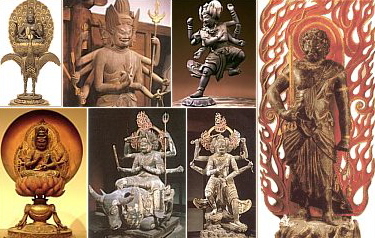  OVERVIEW. The Myō-ō 明王 are warlike and wrathful deities who represent the power of Buddhism to overcome the passions. Five of the Myō-ō are emanations of the Five Buddha of Wisdom (Skt. Dhyāni Buddhas, Jinas), and in this role they guard the four cardinal directions and the center. Introduced to Japan in the 9th century by Japan’s Shingon and Tendai sects of Esoteric Buddhism (Mikkyō 密教), the Myō-ō were originally Hindu deities who were later adopted into the pantheon of Esoteric Buddhism to vanquish blind craving. The teachings of Esoteric Buddhism are mystical and hard to understand, and require a high level of devotion and austerity to master. Elaborate and secret ritual practices (utilizing mantras and mudras and mandalas) are used to help partitioners develop and realize the eternal wisdom of the Buddha. This form of Buddhism is not taught to the general public, but is confined mostly to Buddhist believers, priests and those far along the path toward enlightenment. OVERVIEW. The Myō-ō 明王 are warlike and wrathful deities who represent the power of Buddhism to overcome the passions. Five of the Myō-ō are emanations of the Five Buddha of Wisdom (Skt. Dhyāni Buddhas, Jinas), and in this role they guard the four cardinal directions and the center. Introduced to Japan in the 9th century by Japan’s Shingon and Tendai sects of Esoteric Buddhism (Mikkyō 密教), the Myō-ō were originally Hindu deities who were later adopted into the pantheon of Esoteric Buddhism to vanquish blind craving. The teachings of Esoteric Buddhism are mystical and hard to understand, and require a high level of devotion and austerity to master. Elaborate and secret ritual practices (utilizing mantras and mudras and mandalas) are used to help partitioners develop and realize the eternal wisdom of the Buddha. This form of Buddhism is not taught to the general public, but is confined mostly to Buddhist believers, priests and those far along the path toward enlightenment.
Esoteric Buddhism’s main practitioners in Japan were Priest Kūkai 空海 (774 - 835 AD) and Priest Saichō (767 - 822 AD). Kūkai, also called Kōbō Daishi 弘法大師, founded the Shingon Sect of Esoteric Buddhism, while Priest Saichō founded the Tendai Sect. The Myō-ō protect the Buddhist faith and force its outside enemies to surrender. Today, the Myō-ō are revered mainly by the Tendai sect and by the Shingon sect. The latter emphasizes the Great Sun Sutra (Mahavairocana Sutra) and worships Dainichi Nyorai (Mahavairocana) as the Cosmic Buddha. Indeed, the Myō-ō are the messengers of Dainichi Nyorai, and represent Dainichi’s wrath against evil and ignorance. Among this group of deities, Fudō Myō-ō is the most widely venerated in Japan, and the chief of all the others. Click here for a special page devoted to Fudō.

GODAI MYO-O 五大明王, FIVE GREAT KINGS
In contrast to the saintly images of the Nyorai (Buddha) and Bosatsu (Bodhisattva), images of the Myō-ō are ferocious and menacing, for their threatening postures and facial expressions are designed to subdue evil spirits and convert nonbelievers. They are often depicted engulfed in flame, which according to Buddhist lore, represents the purification of the mind by the burning away of all material desires or the consuming of all passions. They carry vicious weapons to protect believers and subdue evil. Among Myō-ō sculptures, the Godai Myō-ō (the grouping called the “Five Great Kings”) is the most prevalent; among individual Myō-ō, the most widely venerated in Japan is Fudō (literally immovable, steadfast). This group of five serve the Nyorai. Another group of eight serves the Bosatsu and is called the Hachidai Myō-ō 八大明王. For many more details on the eight, see the Digital Dictionary of Buddhism (sign in with user name = guest).
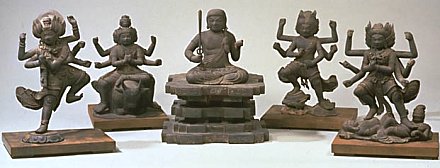
The Five Great Kings, Nara National Museum (Japanese language only)
Fudō (center); Left to Right Gundari, Daitoku, Kongō-Yasha, Gōsanze
FIVE GREAT MYŌ-Ō, Jp. = Godai Myō-ō = 五大明王
Emanations of the Five Transcendental Buddha (Skt. = Dhyāni Buddhas, Jinas)
- Fudō 不動明王 (Skt. Acalanatha), center, emanation of Dainichi (Skt. Vairochana)
- Gōzanze 降三世明王 (Skt. Trilokavijaya), east, emanation of Ashuku (Skt. Akṣobhya)
- Gundari 軍荼利明王 (Skt. Kundali), south, emanation of Hōshō (Skt. Ratnasambhava)
- Daiitoku 大威徳明王 (Skt. Yamantaka), west, emanation of Amida (Skt. Amitābha)
- Kongōyasha 金剛夜叉明王 (Skt. Vajrayaksha), north, emanation of Fukūjōju (Skt. Amoghasiddhi)
GROUPING OF EIGHT, Jp. = Hachidai Myō-ō = 八大明王
- Gōzanze Kongō 降三世金剛明王
- Roppi Rokuto Rokusoku Kongō 六臂六頭六足金剛明王 (Daiitoku)
- Daishō Kongō 大笑金剛明王 (Gundari)
- Dairin Kongō 大輪金剛明王
- Batō Kongō 馬頭金剛明王
- Munoshō Kongō 無能勝金剛明王
- Fudōson Kongō 不動尊金剛明王
- Buchaku Kongō 歩擲金剛明王
ANOTHER GROUPING OF EIGHT, Jp. = Hachidai Myō-ō = 八大明王
- Fudōson 不動尊
- Gōzanzeson 降三世尊
- Gundari 軍荼利
- Rokusokuson 六足尊 (Daiitoku)
- Kongōyakusha 金剛藥叉
- Eshaku Kongō 穢積金剛 (Ususama)
- Munoshō 無能勝
- Batō Kannon 馬頭觀音
SOURCES: Digital Dictionary of Buddhism (login with User ID = guest) and JAANUS and others
|
Jump to Top of Page
|
|
FUDŌ, FUDO,
FUDOU
OFUDOSAN
不動明王

Sanskrit Seed:
KAN
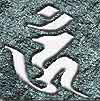
Sanskrit Seed:
UN
Name:
Acala-vidyaraja
(God of Fire)
Acalanatha
means
“Immovable”
Some say Fudō is the Hindu God Shiva. Flames in background said to represent the purification of the mind; in Kamakura, Fudō is enshrined at Joju-in and Myō-ō-in. Others say flame behind Fudō originated from the vomit of the mythical Karura.
|
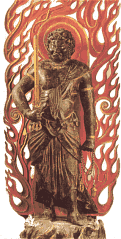 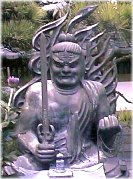

FUDŌ MYŌ-Ō
CLICK HERE FOR SPECIAL PAGE
DEVOTED TO FUDŌ MYŌ-Ō
Fudō’s Shingon Mantra in Japanese
なーまくさーまんだーば さらなんせんだ
まーかろしゃーな そわたやうんたらた かんまん
Naamakusaamandaaba Saranansenda Maakaroshya-na Sowatayauntarata Kanman
Positioned in Center. Personification of Dainichi Nyorai; best known of the five, and one of the main deities of the Shingon sect. Converts anger into salvation; furious, glaring face, as Fudō seeks to frighten people into accepting the teachings of Dainichi; carries “kurikara” or devil-subduing sword in right hand (also represents wisdom cutting through ignorance and used to combat the three poisons (greed, anger, ignorance); holds rope in left hand (to catch and bind up demons and evil); often has third eye in forehead (all-seeing); often seated or standing on rock (because Fudō is “immovable” in his faith). In sculpture, Fudō is often flanked by two attendants, Kongara Dōji 矜羯羅童子 and Seitaka Dōji 制た迦童子. Fudō is also one of the 13 Deities 十三仏 (Jūsanbutsu) of the Shingon Sect of Esoteric Buddhism (Mikkyō 密教) in Japan. In this role, Fudō presides over the memorial service held on the 7th day following one's death. In Japan, Fudō is also worshipped as a deity who can bring monetary fortune.
|
|
Jump to Top of Page
|
|
Gōsanze
Gousanze
Gosanze
Gouzanae
Gozanze
降三世明王

Sanskrit Seed
UN
Name:
Trilokavijaya
|
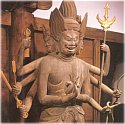

Gōzanze Myō-ō
Positioned in East. The “one who subjugates the three worlds.” Three threatening faces; eight arms; the enemy of foolishness and anger. Carries "Arrow of Mercy" to shoot at people who stray from path toward enlightenment; stands on two other deities, Daijizaiten 大自在天 and Daijizaiten’s consort Uma 烏摩, who he converts into Buddhist protectors.

Gōzanze Mantra in Japanese
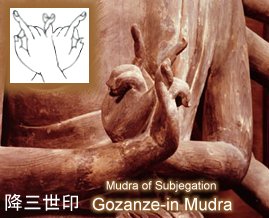
Gōzanze-in 降三世印
Mudra of Subjegation
One panel in the Kongokai Mandala is called the Gōzanze-e Panel.
The below quote comes from the incredibly wonderful online dictionary named JAANUS: “Gōzanze Myō-ō (also Shouzanze Myouou 勝三世明王). Literally “the one who subjugates the three worlds (Sk: Trailokyavijaya).” Also known as Bazaraunkara 縛日羅吽迦羅 (Sk: Vajrahumkara) or Souba Myouou 孫婆明王 (Sk: Sumbha). The second most important after Fudou. Gouzanae represents the wrathful manifestation of Ashuku 阿しゅく and his reflex Kongousatta 金剛薩た and presides over the eastern quarter. He is also regarded as the wrathful manifestation of Dainichi Nyorai in the Kongoukai Mandala (Diamond World Mandala), in contrast to Fudou, who is the wrathful manifestation of Dainichi in the Taizoukai Mandala. He is said to have vanquished Daijizaiten 大自在天 (Skt: Mahesvara, viz. Siva), lord of three realms of desire, form and non-form, when the latter refused to submit to Dainichi, and hence he is known as Gouzanze or "he who subjugates the three worlds," although the "three worlds" are also said to refer to the "three poisons" of greed, anger and ignorance. Chapter two of the KONGOUCHOUKYOU 金剛頂経 deals with his subjugation of Daijizaiten. As is suggested by his name, he is invoked in particular for rites of subjugation. He is represented in a variety of forms, including four faces and eight arms, three faces and eight arms, and one face and four or six arms, but most commomly he has three faces and eight arms and stands trampling Daijizaiten and his consort Uma 烏摩 (Skt: Uma underfoot. There is some debate over whether or not Gouzanze and Shouzanze are identical, and in the Jimyouin 持明院 of the Matrix Mandala they are depicted separately, the former with three faces and eight arms and seated on a lotus with one knee raised and the latter with one face and two arms and seated on a stone pedestal. Artistic representations of Gouzanze, both statuary and pictorial, are usually found in sets of the Godai Myouou (The Five Myouou), but there is a single wooden seated image at Kongouji 金剛寺 (Osaka), and there is also a mandala dedicated to him, Gouzanze Mandara 降三世曼荼羅.” < end quote from JAANUS >
|
|
Jump to Top of Page
|
|
Gundari
軍荼利明王

Sanskrit Seed
UN
Name:
Kundali
|
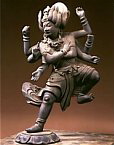

Gundari Myō-ō
Photo courtesy Nara Nat’l Museum

Gundari Mantra in Japanese
Positioned in South. Three faces; eight arms (most holding weapons). Snakes usually coiled around ankles or neck. The enemy of devils.
|
|
Jump to Top of Page
|
|
Daiitoku
(Daitoku)
大威徳明王

Sanskrit Seed:
KIRIIKU
Name:
Yamantaka (Skt)
Yanmandejia (Ch)
|
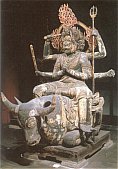

Daiitoku Myō-ō

Daiitoku Mantra in Japanese
Positioned in West. Six faces; six legs; six arms holding various weapons; riding a white cow (cow is symbol of enlightenment); has power to suppress evil and create goodness; also fights pain and poisons. Guardian deity for Amida Nyorai in the Western Pure Land; power to vanquish poisonous snakes and dragons; worshiped as a deity of victory; Museum of Fine Arts (Boston) has statue of Daitoku from the 10th century.
This deity can come in various manifestations. Says the Flammarion Guide on Buddhism:
In the Garbhadhatu Mandala, under the name of Enmatokukai Kongō, he is positioned in the south-west. His body is blue-black and he is seated on a buffalo or a cow of the same color. In his right hands he holds a sword, an arrow and a staff, and in his left hands a trident, a bow, and a rope. His commonest position is with two legs crossed in Padmasana, the other two resting on the ground to the right, and the remaining two bent on the side of the animal. In this case he has three heads from the front: the central one has the appearance of a Bodhisattva, sometimes surmounted by an image of Amida Nyorai. <end Flammarion quote>
|
|
Jump to Top of Page
|
|
Kongō Yaksha,
Kongou-Yasha
Kongo Yaksha
金剛夜叉明王

Seed Sound:
UN
Name:
Vajra-yaksa
Seed image
courtesy
this J-Site
|
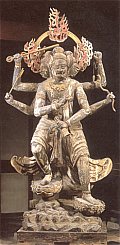

Kongō Yaksha Myō-ō

Kongō Yaksha Mantra in Japanese
Positioned in North. Three angry faces; six arms (or one head and four arms); destroyer of foolish human desires; symbolizes strength. Tendai Buddhists replace Kongo Yasha with Ususama Myouou.
Kongouyasha Myouou 金剛夜叉明王, Below text courtesy of JAANUS
Also written 金剛薬叉明王. "Kongouyasha" corresponds to Sanskrit Vajrayaksa, which is also the name of one of the sixteen great bodhisattvas (juuroku daibosatsu 十六大菩薩) of the Kongoukai Mandara 金剛界曼荼羅. One of the five great myouou (this page), the fierce gods who preside over the five directions. He represents the wrathful manifestation of Fukuujouju 不空成就, one of the five Buddhas of the Diamond Realm and presides over the northern quarter. In the Tendai 天台 sect his position is taken by Ususama Myouou 烏枢沙摩明王, but in the Shingon 真言 sect Kongouyasha and Ususama are clearly differentiated. Blue-black in colour, he is represented with three faces and six arms and standing on a lotus with one leg raised. His central face has five eyes, while the other two faces both have three eyes; his three left hands hold a vajra-bell, bow and wheel, and his three right hands hold a five-pronged vajra, arrow and sword. His rite was believed to be especially efficacious for subduing demons and enemies and for gaining the love and respect of others, but he did not become the object of an independent cult in Japan. Artistic representations of him, both statuary and pictorial, are usually found in sets of the godai myouou, but a polychromepainting of him from the Heian period is preserved at Daigoji 醍醐寺 (Kyoto), and there is also a mandala dedicated to him (Kongouyasha mandara 金剛夜叉曼荼羅).
|
|
Jump to Top of Page
|
|
Ususama
Usūsama Myō-ō
烏枢沙摩明王

Seed Sound:
UN
Sanskrit:
Ucchushma or
Ucchuṣma
Chinese:
Wūshūshāmó
MíngWáng
Also known as
Fujō Kongō 不淨金剛
(Chn. = Bùjìng Jīngāng)
Seed image
courtesy
this J-Site
|
|
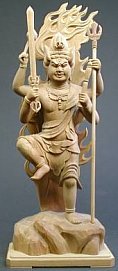
Photo Butsuzou.com (J)
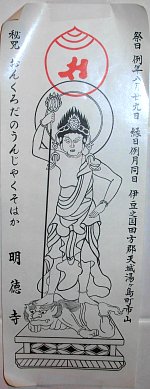
Ususama scroll with
mantra found in some
toilet rooms in Japan.
Above scroll as found
at Myōtokuji Temple 明徳寺 (Yugashima, Izu City)
Says site reader Adam Lebowitz: “In the temple grounds, there is a huge stump with an outgrowth resembling the female appendage, and mid-aged women pat it to ensure later-life health in those areas.”
|
|
 Tendai Buddhists replace Kongō Yasha with Usūsama. Usūsama was introduced to Japan from China by the priest Kūkai 空海 (774-835 AD), and was invoked in rites especially for easy childbirth and for warding off the impurities associated with childbirth. In the Shingon and Zen sects, Usūsama is also revered as the tutelary god of the toilet (see photo below). Tendai Buddhists replace Kongō Yasha with Usūsama. Usūsama was introduced to Japan from China by the priest Kūkai 空海 (774-835 AD), and was invoked in rites especially for easy childbirth and for warding off the impurities associated with childbirth. In the Shingon and Zen sects, Usūsama is also revered as the tutelary god of the toilet (see photo below).
Below text from BuddhistInformation.
Usūsama Myō-ō is the god of the lavatory. Ucchuṣma (or Ucchushma) in Sanskrit means to dry or parch, that is, to clean up filth by burning, by fire, for fire is a great purifying agent. Says the Digital Dictionary of Buddhism: A bodhisattva connected with Fudō Myō-ō 不動明王, one who controls unclean demons. Transliterated as 烏樞沙摩明王 and 烏芻沙摩明王. Also translated into Chinese as 觸金剛 and 不淨忿怒. 〔一切經音義 T 2128.54.545c22 〕.
Below text from JAANUS.
Ususama (also Usushima 烏芻渋摩) is a transliteration of Sanskrit Ucchusma, originally an epithet of Agni, the Indian god of fire, meaning "one whose crackling becomes manifest." He is also known by various other names such as Eshaku Kongou 穢跡(積)金剛, Jusoku Kongou 受触金剛 and Kazu Kongou 火頭金剛. He is regarded by some as the wrathful manifestation of Fukuujouju 不空成就, one of the Five Buddhas of the Diamond Realm (Kongoukai Gobutsu 金剛界五仏) and in the Tendai sect he replaces Kongouyasha Myou-ou 金剛夜叉明王 as one of the five great myou-ou who are the fierce gods who preside over the five directions, in which case he oversees the northern quarter. His cult appears to have been popular in China, and paintings of him are found among the murals of Dunhuang 敦煌 (Jp. Tonkou) where are preserved the cave paintings of a thousand Buddhas from the T'ang Dynasty (8c). He was introduced to Japan from China by the priest Kuukai 空海 (774-835), and he was invoked especially in rites for easy childbirth and the removal of impurities associated with childbirth. In the Shingon and Zen sects he is also revered as the tutelary god of the toilet. Ususama assumes a variety of wrathful forms with two, four, six or eight arms and is often adorned with skulls and snakes and enveloped in flames. An example of a two-armed image is preserved at Zuiryuuji 瑞龍寺 (Toyama prefecture). The texts also describe a number of mandara associated with Ususama, but there are few actual examples of them.
<end JAANUS quote>
MANTRA: おん くろだなうんじゃく そわか. |
|
Jump to Top of Page
|
|
Aizen
愛染明王
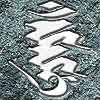
Seed Sound:
U-UN
Name:
Ragaraja
In some sects, considered manifestation of Vairocana
Aizen
is not
known in
India
|
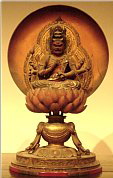

Aizen Myō-ō
PHOTO: Aizen, Kamakura Period, Museum at Tsurugaoka Hachimangu Shrine, Kamakura

Aizen Mantra in Japanese
God of Love among Japan’s Esoteric sects. King of Sexual Passion, converts earthly desires (love/lust) into spiritual awakening; saves people from the pain that comes with love; three faces, three eyes; six arms (typically holding weapons; often wears crown containing a shishi (magical lion); red body, symbolizing the power to purify sexual desire; often carries a bow and arrow (like Cupid); enshrined at Kakuonji Temple in Kamakura.
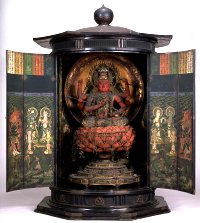
Kamakura Era
Photo courtesy Tokyo National Museum
AIZEN WISH-GRANTING JEWEL. Aizen is closely connected with the magical wish-granting jewel (Jp. = Houjyu 宝珠; Sanskrit = cintamani), as are other Buddhist deities, especially Nyoirin Kannon, Jizo Bosatsu, and Kichijoten. Depending on the deity involved, the jewel can signify the bestowal of blessings on all who suffer, grant wishes, pacify desires, and bring clear understanding of the Dharma (Buddhist law). In Aizen’s case, worshippers often used the jewel to pray for success in their romantic relationships. One important ceremony was called the Jewel of Aizen Myōō Rite (如法愛染王法), pronounced Nyohō Aizen ō hō. The rite was used in the 13th and 14th centuries by esoteric sects to pray for the love and respect of others. This Aizen rite is a variant of the main esoteric ceremony known as the Wish-Granting Jewel Rite (如意宝珠法), pronounced Nyoi Hōju Hō. This rite began sometime in the late Heian period, spearheaded by the Daigo-ji Temple (Shingon sect) in Kyoto.
Source of Info on Wish-Granting Jewel: Ultimate Sacntuaries: The Aesthetics of Buddhist Relic Worship, Nara National Museum Exhibt Catalog, 2001, Printed by Nissha Printing Co. Ltd.
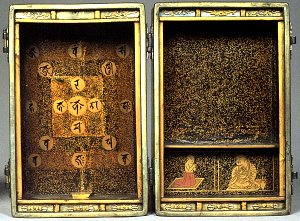
Mandala of Flaming Wish-Granting Jewel
Black-lacquered wood with
makie decorations (sprinkled metal filings)
H = 14.5 cm, width 9.2 cm, depth 9.0 cm
Japan, Nanbokucho - Muromachi Period
14th & 15th Century, Private Collection
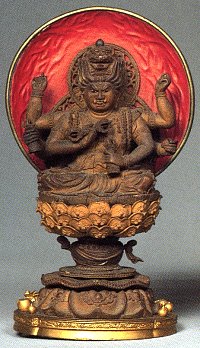
Votive Image of Aizen Myōō Statue
Sandalwood, Height 11.1 cm
14th & 15th Century, Private Collection
PHOTO CREDITS: JEWEL MANDALA & AIZEN STATUE
Ultimate Sacntuaries: The Aesthetics of Buddhist Relic Worship
Nara National Museum, Exhibit Catalog
Copyright 2001. Printed by Nissha Printing Co. Ltd.
Today, Aizen is revered in Japan’s gay quarters as the patron of love. Aizen does not appear in Indian texts, and is unknown amoung India’s deities.
|
|
Jump to Top of Page
|
|
Kujaku
Kujyaku
孔雀明王
Skt.
Mahamayuri
Photo:
Treasure of
Kongoubu-ji Temple
|
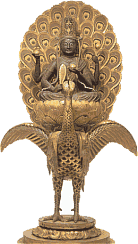 Rain God or Peacock Wisdom King Rain God or Peacock Wisdom King
Wards off evil from poisoning or calamity; prayed to in times of drought, poisoning, and disaster; rides a peacock (in India, the peacock is famous for eating poisonous snakes); one face, four arms.
A larger version of statue at right can be viewed here. Also see a Heian-era photo here.
|
|
Jump to Top of Page
|
|
Batō
Bato
Batou
馬頭明王
Skt.
Hayagriva
|
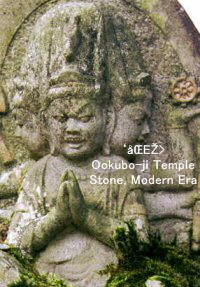  Myō-ō with Horse Head. Myō-ō with Horse Head.
Most often shown with three faces and eight arms; able to eat anything, thus called on in times of need -- i.e., Bato will "eat" your troubles away.
Batō Myō-ō is one of the many incarnations of Batō Kannon, and is more venerated in China than in Japan. Visit the Batō Kannon link for more details. Above photo courtesy of this Japanese site.
|
|
Shinshoji Temple (in Narita, near Narita Int’l Airport)
Shinshoji is dedicated solely to the Myō-ō. Its main object of worship is a statue of Fudō Myō-ō. Behind the main hall stands a huge tower (erected in 1984) housing a complete set of the Godai Myō-ō (The Five Myo-o).
|

 |
|
The Knowledge Kings, The Vidyarajas
|
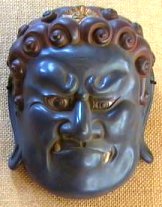
Fudō Mask
Available online at
This J-Site
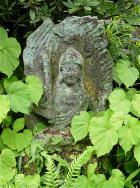
Fudō in Private Garden
Stone, circu 1920
|
|
 These esoteric deities are the kings of mystic knowledge who represent the power of the Buddhas to vanquish blind craving. They are known as the the kings of mystic knowledge because they wield the mantras, which are the mystical spells made up of Sanskrit syllables imbued with the power to protect practitioners of the Dharma (Buddhist Law) from all harm and evil influences. The Vidyarajas appear in terrifying wrathful forms because they embody the indomitable energy of compassion which breaks down all obstacles to wisdom and liberation. These esoteric deities are the kings of mystic knowledge who represent the power of the Buddhas to vanquish blind craving. They are known as the the kings of mystic knowledge because they wield the mantras, which are the mystical spells made up of Sanskrit syllables imbued with the power to protect practitioners of the Dharma (Buddhist Law) from all harm and evil influences. The Vidyarajas appear in terrifying wrathful forms because they embody the indomitable energy of compassion which breaks down all obstacles to wisdom and liberation.
There are two groups of Vidyarajas that are well known. The most famous is the group of five led by Fudo Myo-o. These five are the emanations of the Buddhas of the four cardinal directions and the center which figure prominently in Esoteric Buddhist practice. There is also a group of eight, which includes Aizen Myo-o, who are emanations of the Bodhisattvas.
The two Vidyarajas who appear on the mandala are Achalanatha and Ragaraja, known in Japanese as Fudo Myo-o and Aizen Myo-o respectively. They are each represented by their respective bijas, "seed syllables" that embody their essence. In this case, the seed syllables are written in Siddham, a variant of Sanskrit. They are the only parts of the mandala written in the form of Sanskrit bijas. According to Jacqueline Stone, Fudo Myo-o and Aizen Myo-o represent, respectively, the doctrines that samsara is nirvana (shoji soku nehan in Japanese) and “the defilements are bodhi“ (bonno soku bodai in Japanese)." The first principle means that nirvana is not another realm but the true reality of the world of birth and death. The second principle means that bodhi, or enlightenment, is not the eradication of the defilements, but their liberation and transmutation into the wholesome energy of the enlightened mind.
Fudo Myo-o and Aizen Myo-o are sometimes identified with the Nio, the Two Deva Kings, who are a dual form of Dainichi Nyorai, who is a personification of the Dharmakaya or universal body of the Buddha. As such, Fudo Myo-o represents the element of spirit or mind, the Diamond World Mandala, and subjective wisdom; while Aizen Myo-o represents the five elements of earth, air, fire, water, and space, as well as the Womb World Mandala, and objective truth. Together the pair represent all of the things which are united in the universal life of the Buddha - body and mind, wisdom and truth, and the two mandalas (Ryokai Mandara). The Two Nio Kings are often found guarding the main gates to temple and monasteries as fierce giant warriors. Above
text courtesy: campross.crosswinds.net/ShuteiMandala/myo-o.html |

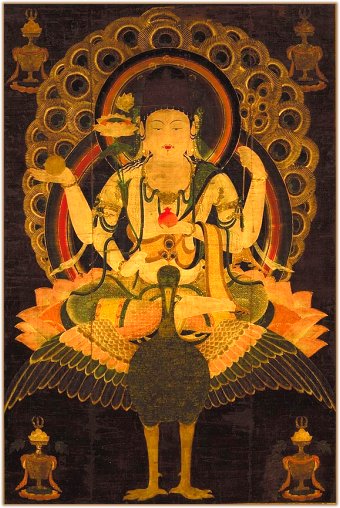
Above: Heian Era Painting
Kujaku (Sanskrit Mahamayuri) = Peacock Wisdom King
National Treasure, Tokyo National Museum
Photo courtesy of www.kyohaku.go.jp/tokuten/elegance/eleg3e.htm
A Chinese Painting of the Same Deity found at:
www.kyohaku.go.jp/eng/syuzou/meihin/kaiga/chuugoku/item08.html

 Daigensui Myō-ō 大元帥明王 Daigensui Myō-ō 大元帥明王
Below text courtesy of JAANUS
Also called Taigensui Myouou 太元帥明王. Sometimes read Daigen Myouou. In Sanskrit Atavaka, which means "lord of the forest," and which is transliterated in Sino-Japanese texts as Atabaku. Originally a child-eating demon, he was converted by the Buddha and became a protector and helper (Yasha 夜叉). Thus he was a deity of non-Buddhist origin assimilated into esoteric Buddhism. His name appears among the sixteen "Good Gods" (juuroku zenjin 十六善神) who protected the DAIHANNYAKYOU 大般若経 and among the eight attendants of Bishamonten 毘沙門天. Associated with for protection of the country and the submission of enemies, he is the principal deity (honzon 本尊) of the rite called daigensuihou 大元帥法.
His name appears in several early esoteric texts, while in the 6c the ATABAKU KIJIN TAISHOU JOUBUTSU DARANIKYOU 阿た婆拘鬼神大将上仏陀羅尼経 was translated, and in the Tang Shanwuwei 善無畏 (Jp: Zenmui, Sk:Subharasimha, 637-735) translated the three-fascicle ATABAKU GENSUI TAISHOU JOUBUTSU DARANIKYOU SHUGYOU GIKI 阿叱薄倶元帥大将上仏陀羅尼経修行儀軌. This Daigensui was the focus of a ceremony at least by that time which was to develop into the ritual still performed in the Imperial palace, the history of which can be traced as follows. Kuukai 空海 (774-835) brought to Japan the first text dealing with Daigensui. However, the monk who actually transmitted the secret ritual appears to have been Jougyou/Jougyou 常暁 (?-866) of Ogurusu Hourinji 小栗栖法琳寺 in Kyoto, who had received esoteric initiation from Kuukai. Jougyou arrived in China in 838, 34 years after Kuukai, and returned to Japan the following year with a collection of iconographic texts and art, amongst which were several texts and images concerned with Daigensui that he had received, along with instruction, from a Chinese master. Jougyou was succeeded by Chouju 寵寿. Emperor Ninmyou 仁明 heard about the miraculous power of the Daigen suihou and the ritual was performed in 840 in the palace's Jouneiden 常寧殿. Beginning in 851 it was celebrated as part of the ceremonies of the goshichinichi-no-mishuhou 御七日御修法 performed under the supervision of the head of Touji 東寺 in the Shingon'in 真言院 of the imperial palace at the New Year. It was also celebrated in a hall of Ogurusu Hourinji. Following the precedent set by Chouju when he celebrated the ritual of Daigensui to quell a rebellion by Silla (Jp: Shiragi 新羅) in 870, the ritual had the specific purpose of quelling foreign enemies. The daigensuihou was commisioned at Hourinji for the quelling of internal rebellions, such as that of Taira no Masakado 平将門, for the suppression of Kantou 関東 forces in 1181, and for the protection of the country from the Mongol invasion in 1281. After the loss of Hourinji in the Muromachi period, the honzon was transferred to the Rishouin 理性院 of Daigoji 醍醐寺, Kyoto, and the ceremony continued to be held until 1871. It is now performed in Touji in place of the goshichinichi-no-mishuhou in the year following the accession of an emperor. Since this ritual is meticulously documented, the use of art in it is unusually well understood.
Usually six scrolls were hung around a dais on which the ritual paraphernalia were placed. The three scrolls hung in the east, facing the officiant, were of three different forms of Daigensui. The central figure had 18 faces and 30 (or 36) arms, the one to the north had six faces and eight arms, while the one to the south had one face and four arms. All were extremely fierce in expression and blue-black in color. The north wall held a Shaka mandara 釈迦曼荼羅 and a Bishamon mandara 毘沙門曼荼羅, while the south wall held a Kokuuzou mandara 虚空蔵曼荼羅 . There are relatively few images of Daigensui but those extant are remarkable. They include the Kamakura period painting of Yoshiminedera 善峰寺 in Kyoto, which shows actual images (probably those of Ogurusu Hourinji) of Daigensui surrounded by the Shitennou 四天王. Six paintings used in the ritual at Daigoji are extant and were made by Kenshin 賢信 following the loss to fire in 1313 of the Hourinji set. These are unusually vivid paintings, using brilliant red and green, that show fierce deities hung with snakes and animal skins. Also part of the ritual set is a Shaka mandara 釈迦曼荼羅 (or Honjin shoubu mandara 本身将部曼荼羅) that has as its central image a seated form of Daigensui with four faces (the central one gentle) and six arms. There is one equally remarkable sculpture of Daigensui in Akishinodera 秋篠寺, Nara Pref. It dates from the late Kamakura period and is kept as a hibutsu 秘仏 (hidden Buddhist image) in the Daigendou Hall 大元堂. Iconographic drawings of Daigensui are held by Touji and Daigoji. < end JAANUS quote >

LEARN MORE - Myō-ō Kings
- Buddhist-Artwork.com. Fudō & Aizen & Kujaku statues
available for online purchase at our sister site.

- Japan Art and Architecture Net Users System (JAANUS)
Perhaps the best online database currently available on topics related to Japanese Buddhist art and iconography. Click here to visit JAANUS, and then use their search engine to find what you want.
- SANSKRIT IMAGES & MANTRAS by permission from Tobifudo (J-site)
- Handbook on Viewing Buddhist Statues
A totally wonderful book. Some images shown on this web page were scanned from this book; Japanese language only; 192 pages; 80 or so color photos. By author Ishii Ayako. Click here to buy book at Amazon
- Reading Buddhist Art: An Illustrated Guide to Buddhist Signs & Symbols. ISBN 0-500-28428-8, Published 2002 by Thames & Hudson. By Meher McArthur, the curator of East Asian Art at the Pacific Asia Museum (Pasadena). Click here to view or buy book at Amazon.

|
|